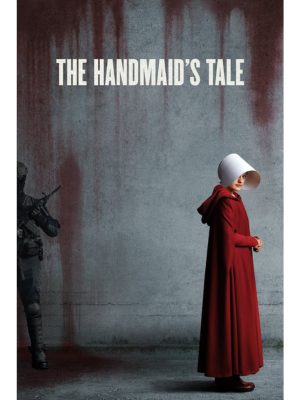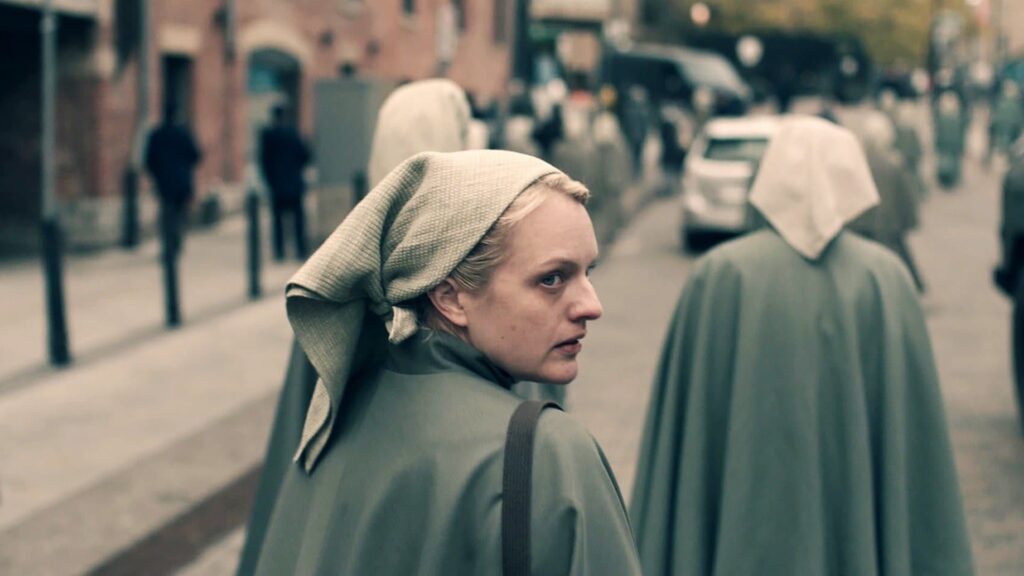The Handmaid's Tale

(2017-) TV-MA, 1h
Table of Contents
What Is The Handmaid’s Tale About?
In a dystopian future, a woman is compelled to live as a forced partner in a strict religious dictatorship.
Why You Should Watch The Handmaid’s Tale
The Handmaid’s Tale, a gripping adaptation of Margaret Atwood’s novel, is a harrowing exploration of a dystopian world that feels uncomfortably close to reality. The series, set in the totalitarian state of Gilead, showcases a society where women’s rights are stripped away, and they are reduced to their reproductive capabilities. This chilling portrayal is anchored by a stellar cast, delivering performances that are both powerful and nuanced.
Elisabeth Moss, as June Osborne, delivers a riveting performance that anchors the show. Her portrayal of June’s transformation from a subdued handmaid to a rebellious force is both convincing and inspiring. Moss’s ability to convey a range of emotions, from despair to determination, often with minimal dialogue, is a testament to her skill as an actress. Her performance not only drives the narrative but also serves as a focal point for the audience’s emotional engagement with the story.

The narrative structure of The Handmaid’s Tale is particularly effective in drawing viewers into its world. The use of flashbacks provides context to the current state of Gilead, juxtaposing the characters’ past lives with their present, often grim reality. This contrast not only heightens the sense of loss and despair but also reinforces the themes of resistance and hope. The storytelling is both intelligent and engaging, successfully maintaining a balance between character development and plot advancement.
Supporting characters in the series also contribute significantly to its depth. Yvonne Strahovski’s portrayal of Serena Joy is complex and layered, offering insight into the internal conflicts faced by those who helped create Gilead. Joseph Fiennes, as Commander Fred Waterford, embodies the hypocrisy and cruelty of the regime, making him a character that viewers love to hate. The interactions between these characters and June are fraught with tension and power dynamics, adding layers of intrigue to the narrative.

The production design and costumes in The Handmaid’s Tale deserve special mention. The stark contrast between the handmaids’ red robes and the bleak surroundings of Gilead creates a visual impact that underscores the oppression and control exerted by the regime. The attention to detail in the sets and costumes adds authenticity to the world of Gilead, making the story more immersive and believable.
Furthermore, the series does not shy away from tackling difficult and sensitive subjects. It confronts issues such as sexual assault, subjugation, and the consequences of totalitarian rule head-on, provoking thought and discussion among its audience. The show’s willingness to address these topics unflinchingly adds to its relevance and impact in the current sociopolitical climate.

The Handmaid’s Tale is a compelling, thought-provoking series that masterfully brings Atwood’s dystopian vision to life. It combines outstanding performances, intelligent storytelling, and meticulous production to create a show that is not only entertaining but also deeply resonant. The series is a powerful reminder of the importance of resisting oppression and valuing freedom, making it a must-watch for audiences seeking a show with both substance and emotional depth.
The Theme of The Handmaid’s Tale
The Handmaid’s Tale delves into a myriad of complex themes that contribute to its profound impact as a dystopian narrative. One of the most prominent themes is the manipulation and presence of power. In the theocratic dictatorship of Gilead, power is top-down, overtly visible, and unchallenged. This power structure leads to extreme surveillance and a deep sense of isolation among individuals, as the only freedom left is within their own minds.
Control of sex and sexuality is another significant theme. Gilead’s regime focuses intensely on regulating sexual behaviors and relationships, reflecting both a fear and an underestimation of human sexuality. This theme is underscored by the execution of homosexuals, the destruction of pornography, the outlawing of divorce and second marriages, and the ritualization of sex as per their interpretation of the Bible. This desperate attempt to control sexuality ultimately contributes to the regime’s downfall.

The novel also explores the tension between the needs of society and the rights of the individual. Gilead, facing a demographic crisis, takes extreme measures that prioritize societal needs over individual rights. This theme raises questions about the morality and efficacy of utilitarian approaches in extreme situations.
Feminism in “The Handmaid’s Tale” is presented in a complex light. Margaret Atwood, often regarded as a feminist writer, uses the novel to explore different facets of feminism, both in its utopian ideals and its practical failures. The narrative suggests that the belief in an inherent loyalty among women might be misguided, and it highlights the gaps between feminist ideals and reality.

Language and storytelling form another key theme. The narrative emphasizes the power of language and the act of storytelling as a means of survival and resistance. Offred’s narrative is a re-interpretation of her experiences, underscoring the idea that storytelling can be a powerful tool against oppressive regimes.
Atwood also raises questions about moral relativism and the possibility of judging a culture from an external standpoint. The narrative suggests that despite cultural differences, certain underlying relationships and power dynamics are universal, allowing for a critical evaluation of different societies.

Lastly, the theme of gender conflict is central to the narrative. The story illustrates the deepening divide between men and women under the Gileadean regime, questioning whether these conflicts are inherent or a product of societal structures. The narrative doesn’t provide concrete answers but instead presents the complexities and nuances of gender relations in both the old and the new societal orders.
The Cinematography of The Handmaid’s Tale
One of the most striking features of the cinematography is its use of color. The series employs a muted, almost washed-out color palette that creates a bleak, oppressive atmosphere. This starkness is contrasted with the vibrant red of the Handmaids’ attire, symbolizing both their fertility and their subjugation. The use of color not only distinguishes different classes within the society but also reflects the emotional state and journey of the characters.
Lighting is another crucial element in the series’ visual storytelling. The use of natural light, often dim or obscured, contributes to the overall feeling of confinement and despair. Scenes are frequently underlit, adding a sense of mystery and unease. This choice in lighting emphasizes the claustrophobic and controlled environment the characters inhabit, where darkness often represents the truth hidden from the public eye.

Framing and composition in The Handmaid’s Tale are deliberately crafted to evoke a sense of entrapment and surveillance. Tight close-ups on characters’ faces, particularly the Handmaids, capture their emotional turmoil and resilience. The frequent use of shallow focus isolates characters within their environment, reflecting their isolation and disconnection from the world around them. High-angle shots are often used to depict the Handmaids, reinforcing their powerless position in society.
The series also makes significant use of symbolism through its visual elements. Objects such as the bonnets worn by the Handmaids, the eye iconography representing the oppressive regime, and the use of mirrors to reflect a character’s internal conflict, all contribute to the deeper meaning and themes of the show. These symbols are woven seamlessly into the visual narrative, enriching the storytelling.

The cinematography effectively juxtaposes the present dystopian setting with flashbacks to a more normal past. These flashbacks are often brighter and more vivid, creating a stark contrast with the present and emphasizing what has been lost. This contrast serves as a powerful reminder of the characters’ past lives and the freedom they once had, making their current situation even more poignant.
The Soundtrack of The Handmaid’s Tale
The soundtrack of The Handmaid’s Tale, composed by Adam Taylor, plays a crucial role in accentuating the series’ tense and ominous atmosphere. Taylor’s music is dark and brooding, crafted to mirror the series’ narrative and enhance the emotional connection with the audience. His minimalist theme begins with a simple guitar ostinato and evolves with the inclusion of strings, digital samples, and impactful percussion.

Additionally, the soundtrack features a mix of contemporary and classical music, enriching the series’ soundscape:
- Chopin’s Nocturne Op. 9, No. 2 in Season 4, Episode 3.
- Max Richter’s On The Nature of Daylight in the Season 4 finale.
- Music by Hildur Guðnadóttir in a birth scene in Season 1.
- A mashup of Philip Glass’ Violin Concerto with Blondie’s ‘Heart of Glass’ in Season 1.
Taylor’s background as a self-taught musician, who started in bands and church music, informed his contemporary and emotive style, making him popular among music fans for his TV and film scores. His work on The Handmaid’s Tale showcases his ability to create a soundscape that is both evocative and reflective of the series’ themes and moods.
The Cast of The Handmaid’s Tale
- Elisabeth Moss as June Osborne: A woman captured while trying to escape to Canada, made a Handmaid due to her fertility.
- Joseph Fiennes as Commander Fred Waterford: A high-ranking official and June’s master, instrumental in Gilead’s founding.
- Yvonne Strahovski as Serena Joy Waterford: Fred’s wife, a former conservative cultural activist.
- Alexis Bledel as Emily/Ofglen/Ofsteven: June’s ally and a former university lecturer, turned Handmaid.
- Madeline Brewer as Janine/Ofwarren/Ofdaniel: A Handmaid who suffers severe trauma during her service.
- Ann Dowd as Aunt Lydia: Responsible for training Handmaids, known for her harsh methods.
- O-T Fagbenle: as Lucas “Luke” Bankole: June’s husband who escapes to Canada.
- Max Minghella as Nick Blaine: Commander Waterford’s driver, a close confidant of June, and a spy for Gilead.
- Samira Wiley as Moira/Ruby: June’s best friend, initially a Handmaid trainee, later a “Jezebel.”
- Amanda Brugel as Rita: A Martha in the Waterford household, part of the resistance.
- Bradley Whitford as Commander Joseph Lawrence: The architect of Gilead’s economy, a complex character. Bradley is also great in Get Out, too.
- Sam Jaeger as Mark Tuello: A mysterious figure in Canada, revealed as a representative of the US government-in-exile.
The Filmmakers of The Handmaid’s Tale
- Creator: Bruce Miller
- Based on the Novel by: Margaret Atwood
- Starring: Elisabeth Moss, Joseph Fiennes, Yvonne Strahovski, Alexis Bledel, Madeline Brewer, Ann Dowd, O-T Fagbenle, Max Minghella, Samira Wiley, Amanda Brugel, Bradley Whitford, Sam Jaeger
- Composer: Adam Taylor
- Executive Producers: Bruce Miller, Warren Littlefield, Reed Morano, Daniel Wilson, Fran Sears, Ilene Chaiken, Elisabeth Moss, Mike Barker, Eric Tuchman, Yahlin Chang, Sheila Hockin, John Weber, Frank Siracusa, Dorothy Fortenberry
- Consulting Producer: Margaret Atwood, who also had a cameo role in the first episode

Macaroni and Cheese

Inspiration

More About The Handmaid’s Tale
The Handmaid’s Tale, the critically acclaimed Hulu series based on Margaret Atwood’s novel, was primarily filmed in and around Toronto, Canada. This location choice provided a diverse range of urban, suburban, and rural settings that were instrumental in creating the show’s distinctive and oppressive atmosphere.
Key filming locations included:
- Toronto City Hall: This prominent building was used as one of the main shooting locations, including a memorable scene where it was depicted as being blown up by the Handmaids.
- Fred & Serena Waterford’s House: The home of key characters in the series is located at 105 Aberdeen Avenue in Hamilton, Ontario, adding to the authenticity and richness of the show’s setting.
- The River Path – Mill Race Park, Cambridge: This location was another important site used in the series, adding to the show’s dynamic and varied visual landscape.
- Jezebels – Fairmont Royal York Hotel: This location was used to depict the Jezebels club, a pivotal setting in the series.
- The Red Centre – The Church of St. Aidan: This church served as the setting for the Red Centre, a significant location in the series.
- June, Luke, & Moira’s House in Canada: Located at 11 Williams Street, Weston, Toronto, this site was used for scenes involving these key characters.
For the fifth season, many pivotal sequences were filmed across the Greater Toronto Area, a region encompassing 25 municipalities. This included shooting on Queen Street West and around Parkdale Home Hardware, where several street scenes were captured. Additionally, studio work was done at Cinespace Film Studios, further contributing to the show’s high production value.

The Handmaid’s Tale has been the subject of controversy and faced challenges, but it is not universally banned. The book, known for its critical portrayal of a dystopian society where women’s rights are severely restricted, has been a frequent target of censorship attempts in various schools and libraries primarily in the United States. These attempts often cite reasons such as the book’s explicit language, sexual content, and themes deemed inappropriate for certain age groups.
The American Library Association (ALA) has documented several instances where “The Handmaid’s Tale” has been challenged or removed from school curricula and library shelves. Despite these challenges, the novel remains widely available and is celebrated for its exploration of themes related to women’s rights, totalitarianism, and individual autonomy. It is often included in high school and college curricula for its literary and thematic significance.
The controversy surrounding “The Handmaid’s Tale” reflects broader debates over educational content and the role of literature in discussing complex social and political issues. While it faces challenges in some areas, the novel continues to be an influential and widely discussed work in contemporary literature, sparking conversations about censorship, freedom of expression, and the importance of literature in understanding and critiquing societal norms and structures.

